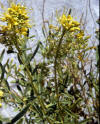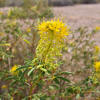|
Wislizenia fruticosa |
Wislizenia fruticosa Spjut & Marin 11627 (BCMEX, US)
|
|
Wislizenia palmeri Near margin of playa, Palen Lake, Sonoran Desert. CNPS Field-Based Rare Vegetation Sampling/Mapping Workshop in East Riverside County, Feb 5–6, 2011.
|
Wislizenia palmeri Image by Sue Carnahan. On SEINet. Reportedly taken in Mexico, Sonora, Guaymas, Alluvial plain near San Jose de Guaymas. 27.98982 -110.83968 WGS84. CC BY-NC (Attribution-Non-Commercial). Presented here for comparison of fruits for the two species shown.
|
|
Trees and Shrubs of Kern County (Jan 2013, Sep 2022) Wislizenia palmeri A. Gray 1873. Type in HUH ("possible" type, high resolution image!, possibly annual). Not in Kern County. Palmer's spectacle fruit. Plants annual, perennial, or shrubs, The shrub habit similar to bladderpod (Isomeris arborea). The fruit separates at maturity into its carpellary units, each containing a single seed. California locations are reported from sand dunes near a dry lake northeast of Desert Center in Riverside Co., and in Anza Borego, San Diego Co. In Arizona reported from the Organ Pipe National Monument, and in Mexico, in state of Sonora. The shrub species, W. fruticosa Greene (holotype US, high resolution image!), is known only from Baja California, Mexico; it flowers in the spring. In Kern County, we have the annual W. refracta Englemann ssp. californica (Greene) S. Keller that flowers in late summer to fall; it is endemic to the Valley. The typical subspecies is much more widely distributed in summer rainfall areas of the southwest. The FNA (Vol. 7) treats the three varieties in California as species. References Greene, E. 1906. Revision of the genus Wislizenia. Proceedings of the Biological Society of Washington 19(28): 127–132. Preston, R.E. & S. S. Vanderpool 2012. Wislizenia refracta subsp. palmeri, in Jepson Flora Project (eds.) Jepson eFlora, https://ucjeps.berkeley.edu/eflora/eflora_display.php?tid=53419, accessed on September 03, 2022 Spjut, R. W. 2022. Jackass Clover, Wislizenia (Cleomaceae), Rare Species in Kern County and Elsewhere.. CNPS Kern Chapter Newsletter, Mimulus Memo, September issue. Tucker, G. C. 2010. Wislizenia. FNA 10: 213–214. Three species: W. palmeri, W. californica, W. refracta.
|
|




